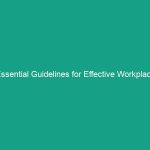Introduction
Good morning team! Today, we’re going to discuss an incredibly important topic: Essential Working Platforms Safety Guidelines: Avoid Costly Mistakes. Understanding these guidelines is crucial not just for compliance, but for ensuring your Safety and the Safety of your coworkers while working on platforms.
As you know, working platforms can be hazardous if proper Safety Measures are not followed. Ignoring these guidelines can lead to serious accidents, injuries, or even fatalities. Our goal today is to equip you with the necessary knowledge to prevent such incidents and promote a culture of safety in our workplace.
Understanding Essential Working Platforms Safety Guidelines
Essential working platforms safety guidelines are a set of Best Practices designed to ensure the safe use of platforms in various work environments. These platforms include scaffolding, aerial lifts, and other elevated work surfaces.
The importance of these guidelines cannot be overstated. They protect you from falls, equipment malfunction, and other Hazards that could disrupt your daily operations. A common misconception is that safety guidelines are just bureaucratic red tape; in reality, they are vital for safeguarding your health and well-being.
Key Hazards, Risks, and Safety Considerations
When working on platforms, several specific hazards and risks can arise:
- Falls: The leading cause of fatalities in construction and Maintenance work.
- Equipment Failure: Malfunctioning equipment can lead to serious injuries.
- Improper Setup: Unstable or poorly erected platforms pose a significant risk.
- Overloading: Exceeding weight limits can cause platforms to collapse.
Ignoring safety protocols can have real-world consequences, including injuries that could result in lost workdays, medical expenses, and even legal liabilities. Always prioritize safety to avoid these costly mistakes!
Best Practices, Procedures, & Actionable Advice
Here are some essential Best Practices to follow when using working platforms:
1. Inspect the Equipment
Before starting any job, perform a thorough inspection of the platform or equipment. Look for:
- Structural integrity
- Functional safety devices
- Signs of wear and tear
If you notice anything unusual, report it immediately and do not use the equipment until it has been cleared for use.
2. Follow Manufacturer Guidelines
Always adhere to the manufacturer’s guidelines for setup, operation, and maintenance. This includes weight limits, assembly instructions, and safety features. Remember, these guidelines are in place for your protection!
3. Use Proper Personal Protective Equipment (PPE)
Wearing the right PPE is crucial. Ensure you have:
- Hard hats
- Safety glasses
- Non-slip footwear
- Fall protection gear, such as harnesses
PPE can significantly reduce the risk of injury in case of an accident.
4. Maintain Clear Communication
Effective communication among team members is vital. Use signals or radios to ensure everyone is aware of the task at hand, especially when Working at Height. This can prevent accidents and improve overall safety.
5. Get Trained!
Ensure that all employees who will be using working platforms have undergone proper Training. Familiarity with safety protocols and equipment Operation can prevent many accidents.
Real-World Case Study
Let’s consider a case where a construction worker fell from an improperly secured scaffolding. The scaffolding had not been inspected, and the workers were not trained in Fall Protection. As a result, the worker sustained serious injuries that led to a prolonged absence from work and significant medical costs for both the worker and the company. This incident could have been avoided by adhering to safety guidelines.
Regulations, Standards, and Compliance
It’s essential to be aware of relevant safety Regulations and Standards, such as those set by OSHA (Occupational Safety and Health Administration) and ISO (International Organization for Standardization). Compliance with these regulations is not optional; it is a legal requirement designed to protect you and your fellow workers.
Failure to comply can result in hefty fines and legal consequences, but more importantly, it puts lives at risk. Always stay updated on safety regulations and ensure your practices align with them.
Employee Engagement & Discussion
Now that we’ve covered the essential guidelines, let’s open the floor for discussion. What safety challenges have you encountered related to working platforms? Have you ever witnessed or experienced a near miss that could have been prevented by following these guidelines?
Sharing experiences can help us all learn and improve our safety practices. Remember, safety is everyone’s responsibility!
Conclusion & Key Takeaways
To wrap up, remember that adhering to essential working platforms safety guidelines is crucial for preventing accidents and ensuring a safe workplace. Here are the key takeaways:
- Always inspect equipment before use.
- Follow manufacturer guidelines and weight limits.
- Wear the appropriate PPE.
- Maintain clear communication with your team.
- Ensure proper training for all employees.
Let’s commit to prioritizing safety in our daily operations. Thank you for your attention and your commitment to maintaining a safe working Environment. Together, we can avoid costly mistakes and keep everyone safe!


